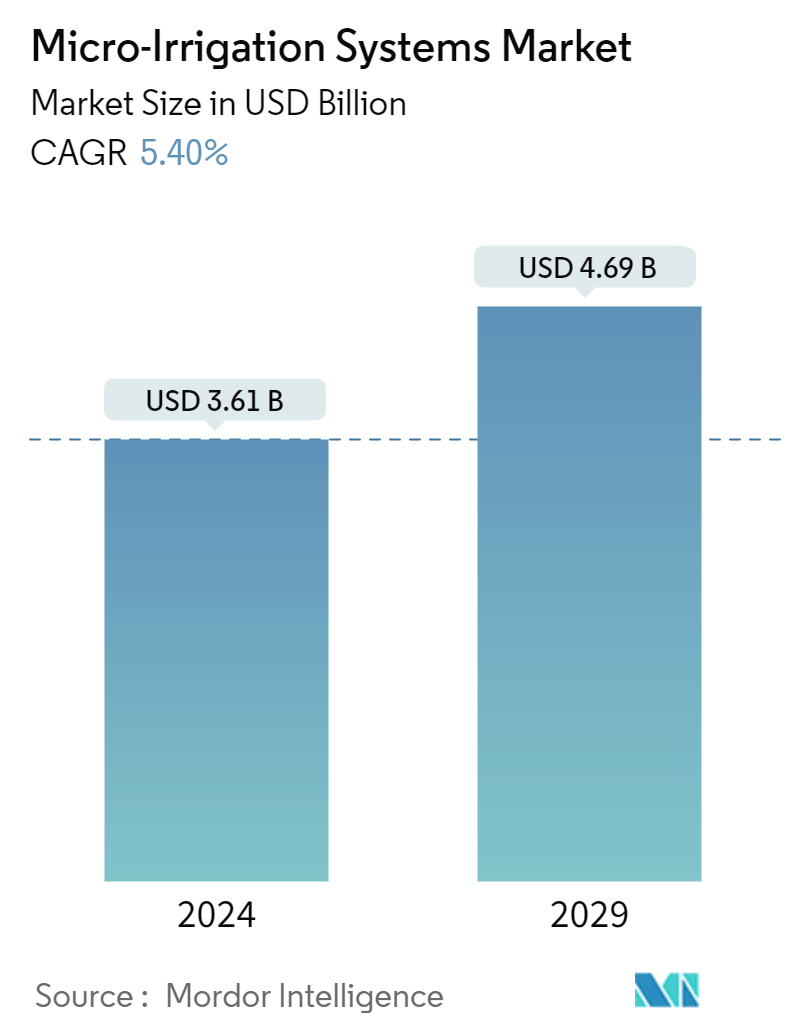Market Size of Micro-Irrigation Systems Industry

| Study Period | 2019 - 2029 |
| Market Size (2024) | USD 3.61 Billion |
| Market Size (2029) | USD 4.69 Billion |
| CAGR (2024 - 2029) | 5.40 % |
| Fastest Growing Market | North America |
| Largest Market | Asia Pacific |
| Market Concentration | High |
Major Players
*Disclaimer: Major Players sorted in no particular order |
Micro-Irrigation Systems Market Analysis
The Micro-Irrigation Systems Market size is estimated at USD 3.61 billion in 2024, and is expected to reach USD 4.69 billion by 2029, growing at a CAGR of 5.40% during the forecast period (2024-2029).
- The micro irrigation systems market is witnessing impressive growth. Key drivers fueling this expansion include global water scarcity, the rising adoption of fertigation practices, and robust backing from government entities worldwide.
- Notably, esteemed organizations like the World Bank are supporting and actively promoting micro-irrigation in Uganda through its Micro-scale Irrigation Program, which is part of the Uganda Intergovernmental Fiscal Transfers Program for Results (UgIFT). Precision farming, sustainable agriculture, and the urgent need for increased food production further bolster the micro irrigation systems market.
- Micro-irrigation adoption has accelerated globally, with Asia-Pacific leading the charge. Within this region, India stands out as the dominant player after China. Several Indian state governments are promoting the use of micro-irrigation. For instance, under the Andhra Pradesh Micro Irrigation Project (APMIP), the state government of Andhra Pradesh is offering a 90% subsidy on irrigation equipment (including micro irrigation) to farmers with less than five acres and 70% for those with larger holdings.
- The micro irrigation systems market is expanding, driven by the rising integration of precision agriculture, especially variable rate irrigation (VRI) technology. This trend is observable in developing and developed nations, fueled by surging food demand. VRI-based micro-irrigation systems optimize water usage, boost crop yields, and reduce input costs by leveraging sensors to monitor soil moisture and crop health. However, significant upfront costs and ongoing maintenance expenses challenge the market's growth.
Micro-Irrigation Systems Industry Segmentation
Micro irrigation is a modern method involving water and nutrients controlled application using drippers, sprinklers, and foggers. This irrigation technology is suitable for many crops since it improves water intake efficiency while reducing fertilizer loss and soil erosion.
The report covers micro irrigation systems market companies and is segmented by mechanism (drip irrigation systems, sprinkler irrigation systems, and other micro-irrigation systems), component (drip irrigation components and sprinkler irrigation components), cultivation technology (open field and protected cultivation), application (field crops, orchards and vineyards, vegetables, plantation crops, and other applications), and geography (North America, Europe, Asia-Pacific, South America, and Africa).
The report offers market size and forecasts for the micro-irrigation systems market in value (USD) for all the above segments.
| Mechanism | |
| Drip Irrigation System | |
| Sprinkler Irrigation System | |
| Other Micro-irrigation Systems |
| Component | |||||||
| |||||||
|
| Cultivation Technology | |
| Open Field | |
| Protected Cultivation |
| Application | |
| Field Crops | |
| Orchards and Vineyards | |
| Vegetables | |
| Plantation Crops | |
| Other Applications |
| Geography | |||||||||
| |||||||||
| |||||||||
| |||||||||
| |||||||||
|
Micro-Irrigation Systems Market Size Summary
The micro-irrigation systems market is experiencing significant growth, driven by the increasing need to enhance agricultural productivity while addressing water scarcity issues. These systems, including drip and sprinkler irrigation, are becoming essential in developed economies for their efficiency in reducing water wastage. Companies like Netafim Ltd are leading the way in providing advanced solutions that integrate seamlessly into agricultural practices, improving the economic conditions of smallholder farmers. The demand for automatic drip irrigation systems is particularly rising due to their ability to manage soil moisture effectively, minimizing human error and optimizing water usage. Governments worldwide are actively promoting the adoption of micro-irrigation technologies through financial and technical support, aiming to expand their coverage and mitigate water shortages.
The market is characterized by a consolidated structure, with major players such as Jain Irrigation Systems Limited, Netafim Limited, and Lindsay Corporation dominating the landscape. These companies are continuously innovating to enhance the efficiency and effectiveness of micro-irrigation systems. For instance, recent developments include the launch of new filtration technologies and smart IoT projects to optimize water usage in agriculture. The Asian region, particularly China and India, plays a crucial role in the market, with China being a leading manufacturer and exporter of micro-irrigation components. The Indian government has also significantly increased its investment in micro-irrigation initiatives, reflecting the growing importance of these systems in reducing reliance on rainfed agriculture and boosting crop yields. As water scarcity becomes a more pressing issue, the micro-irrigation systems market is poised for robust growth, supported by government initiatives and technological advancements.
Micro-Irrigation Systems Market Size - Table of Contents
-
1. MARKET DYNAMICS
-
1.1 Market Overview
-
1.2 Market Drivers
-
1.2.1 Widespread Adoption Could Alleviate Water Scarcity Issues
-
1.2.2 Growing Adoption of Fertigation Techniques
-
1.2.3 Rising Government Support
-
-
1.3 Market Restraints
-
1.3.1 Significant Initial Capital Requirements
-
1.3.2 Challenges in Implementing Due to Their Intricate Setup
-
-
1.4 Porter's Five Forces Analysis-Industry Attractiveness -
-
1.4.1 Bargaining Power of Suppliers
-
1.4.2 Bargaining Power of Buyers
-
1.4.3 Threat of New Entrants
-
1.4.4 Threat of Substitute Products and Services
-
1.4.5 Intensity of Competitive Rivalry
-
-
-
2. MARKET SEGMENTATION
-
2.1 Mechanism
-
2.1.1 Drip Irrigation System
-
2.1.2 Sprinkler Irrigation System
-
2.1.3 Other Micro-irrigation Systems
-
-
2.2 Component
-
2.2.1 Drip Irrigation Components
-
2.2.1.1 Drippers
-
2.2.1.2 Tubing
-
2.2.1.3 Valves and Filters
-
2.2.1.4 Pressure Regulators
-
2.2.1.5 Other Drip Irrigation Components
-
-
2.2.2 Sprinkler Irrigation Components
-
2.2.2.1 Tubing
-
2.2.2.2 Nozzles
-
2.2.2.3 Pressure Regulators
-
2.2.2.4 Other Sprinkler Irrigation Components
-
-
-
2.3 Cultivation Technology
-
2.3.1 Open Field
-
2.3.2 Protected Cultivation
-
-
2.4 Application
-
2.4.1 Field Crops
-
2.4.2 Orchards and Vineyards
-
2.4.3 Vegetables
-
2.4.4 Plantation Crops
-
2.4.5 Other Applications
-
-
2.5 Geography
-
2.5.1 North America
-
2.5.1.1 United States
-
2.5.1.2 Canada
-
2.5.1.3 Mexico
-
2.5.1.4 Rest of North America
-
-
2.5.2 Europe
-
2.5.2.1 Germany
-
2.5.2.2 United Kingdom
-
2.5.2.3 France
-
2.5.2.4 Spain
-
2.5.2.5 Italy
-
2.5.2.6 Russia
-
2.5.2.7 Rest of Europe
-
-
2.5.3 Asia-Pacific
-
2.5.3.1 China
-
2.5.3.2 Japan
-
2.5.3.3 India
-
2.5.3.4 Australia
-
2.5.3.5 South Korea
-
2.5.3.6 Rest of Asia-Pacific
-
-
2.5.4 South America
-
2.5.4.1 Brazil
-
2.5.4.2 Argentina
-
2.5.4.3 Rest of South America
-
-
2.5.5 Africa
-
2.5.5.1 South Africa
-
2.5.5.2 Egypt
-
2.5.5.3 Rest of Africa
-
-
-
Micro-Irrigation Systems Market Size FAQs
How big is the Micro-Irrigation Systems Market?
The Micro-Irrigation Systems Market size is expected to reach USD 3.61 billion in 2024 and grow at a CAGR of 5.40% to reach USD 4.69 billion by 2029.
What is the current Micro-Irrigation Systems Market size?
In 2024, the Micro-Irrigation Systems Market size is expected to reach USD 3.61 billion.

